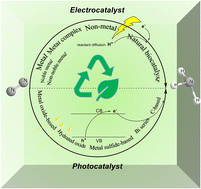A review on catalysts for electrocatalytic and photocatalytic reduction of N2 to ammonia
Abstract
The ammonia (NH3) synthesis industry is significant for many aspects of human progress and the global economy, especially in the fields of fertilizers, hydrocarbon-free energy carriers, and the production of emerging clean fuels. The world's energy for ammonia synthesis accounts for roughly 1–2% of social energy consumption. As an environmentally friendly and cheap raw material, N2 is abundant in nature. Therefore, the search for efficient catalysts that can convert N2 to NH3 under mild conditions with low energy consumption has always been a hot research topic in the field of catalysis. The conversion and utilization of renewable energy sources such as light and electricity, especially chemical energy, is of great importance to human society in terms of energy saving and environmental protection. One of the ways to reduce N2 to NH3 is the electrochemical nitrogen reduction reaction (e-NRR); however, the improvement of e-NRR activity is severely limited by the ultra-high chemical stability of N![[triple bond, length as m-dash]](https://www.rsc.org/images/entities/char_e002.gif) N bonds and the competition from the hydrogen evolution reaction (HER). The three main types of catalysts, metallic (metal complex) and non-metallic catalysts, together with natural biocatalysts, have been the target of development and improvement by researchers as suitable catalysts. In terms of photocatalytic N2 synthesis of ammonia, due to the relatively stable chemical properties of N2 molecules, it is difficult for traditional photocatalytic materials to generate the activity of reducing N2 molecules. Through continuous innovation and improvement of photocatalysts, researchers are able to increase the catalytic sites of catalysts and find suitable supporting materials to activate N2 molecules, which greatly improves the efficiency of photocatalytic N2 synthesis of ammonia. This review highlights the recent progress and development of photocatalysts and electrocatalysts for the synthesis of NH3 from N2, and briefly introduces the advantages of various catalysts and the comparison of synthesis efficiency. It is expected to provide a reference for the development of new processes that can produce high value-added chemicals.
N bonds and the competition from the hydrogen evolution reaction (HER). The three main types of catalysts, metallic (metal complex) and non-metallic catalysts, together with natural biocatalysts, have been the target of development and improvement by researchers as suitable catalysts. In terms of photocatalytic N2 synthesis of ammonia, due to the relatively stable chemical properties of N2 molecules, it is difficult for traditional photocatalytic materials to generate the activity of reducing N2 molecules. Through continuous innovation and improvement of photocatalysts, researchers are able to increase the catalytic sites of catalysts and find suitable supporting materials to activate N2 molecules, which greatly improves the efficiency of photocatalytic N2 synthesis of ammonia. This review highlights the recent progress and development of photocatalysts and electrocatalysts for the synthesis of NH3 from N2, and briefly introduces the advantages of various catalysts and the comparison of synthesis efficiency. It is expected to provide a reference for the development of new processes that can produce high value-added chemicals.

- This article is part of the themed collection: Green Chemistry Reviews


 Please wait while we load your content...
Please wait while we load your content...